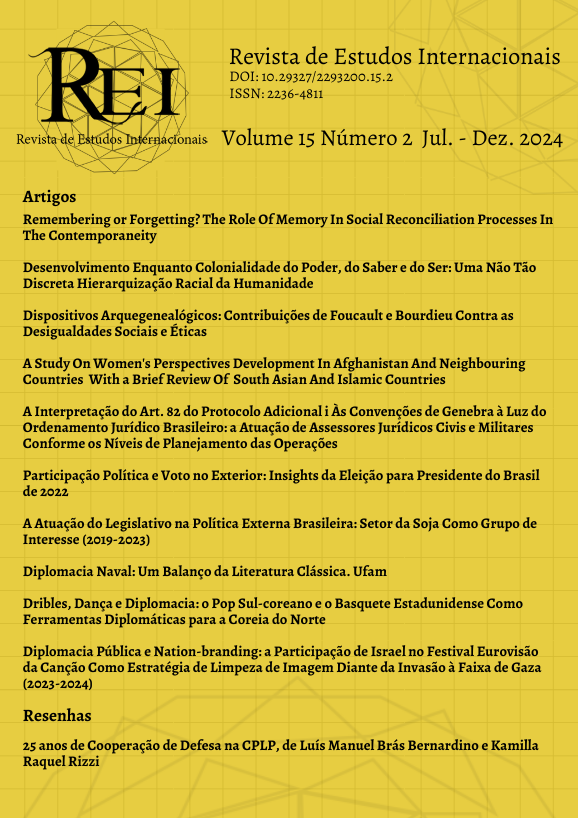WOMEN'S PERSPECTIVES DEVELOPMENT IN AFGHANISTAN AND NEIGHBOURING COUNTRIES WITH A BRIEF REVIEW OF SOUTH ASIAN AND ISLAMIC COUNTRIES
DOI:
https://doi.org/10.29327/2293200.15.2-4Palavras-chave:
EnglishResumo
Este artigo investiga as perspectivas de desenvolvimento das mulheres no Afeganistão em comparação com os países vizinhos, e apresenta breves revisões da literatura sobre a situação das mulheres em países islâmicos e do Sul da Ásia. Através de análises comparativas entre vizinhos do Afeganistão (como o Irão, Paquistão, China, Tajiquistão, Turquemenistão e Uzbequistão) e países do Sul da Ásia (Paquistão, Índia, Bangladesh, Maldivas, Sri Lanka, Nepal e Butão), há enormes disparidades de gênero. O desenvolvimento relacionado ao gênero baseia-se em alguns indicadores do Índice de Desenvolvimento Humano e do Índice de Desigualdade de Gênero (GII). A primeira dimensão é a saúde, medida pela taxa de mortalidade materna e taxa de natalidade adolescente. O segundo é o empoderamento feminino, através de dois elementos: a razão de assentos parlamentares ocupados por mulheres e a razão de mulheres e homens adultos no ensino secundário e sua participação como força de trabalho. Segundo indicadores do GII, a taxa de mortalidade materna e a taxa de natalidade adolescente são de 638 e 69, respectivamente; percebemos que são mais elevadas no Afeganistão. Além disso, no Afeganistão, apenas 19 por cento das mulheres estavam envolvidas no setor agrícola nos países do Sul da Ásia.
Referências
ACHARYA, Upasna and PANDEY, Chittaranjan. (2018, Nov). Women's Entrepreneurial Ecosystem in Nepal: A Study Based on Kathmandu Valley. Research Gate. DOI: 10.47670/wuwijar201822CPUA.
AFROZE, S. S. (2021). Women Entrepreneurs in Bangladesh: Barely Staying Afloat. Dhaka, Bangladesh: Asia Foundation. Available at: [https://asiafoundation.org/2021/05/26/women-entrepreneurs-in-bangladesh-barely-staying-afloat/]. Access: 13/04/2024.
ALBRECHT, Clara; RUDE, Britta and STITTENEDER, Tanja. (2022). Women in Afghanistan: Developments over the Last 20 Years and Returns of the Taliban. CESifo Forum.
AL-LAMKI, S. M. (1999, May 03). A perspective on Omani Women in Management in The Sultanate of Oman. Advancing Women in Leadership Online Journal. Available at: [www.advancingwomen.com]. Access: 13/04/2024.
ARAGON, M. C. (2021). A need for change: Why do women in the judiciary matter? Konrad Adenauer Stiftung, 3-4. doi: 01-12-2023 14:49 +00:00
ASHRAF, I. A. (2018). Socio-Economic Well Being and Women Status in Pakistan: An Empirical Analysis. Munich Personal RePEc Archive.
AU, N. (2017). To Make China's Female Entrepreneurs Count, Let's Go Beyond Just Counting Them. Asia Foundation. Available at: [https://asiafoundation.org/2017/12/13/make-chinas-female-entrepreneurs-count-lets-go-beyond-just-counting/] Access: 13/04/2024.
BECK, L. and KEDDIE, N. (1997). Women in the Muslim World. Harvard University Press. Buttner EH, 34-46.
CARE (2020). Rapid Gender Analysis, Afghanistan. Care. Available at [https://reliefweb.int/sites/reliefweb.int/files/resources/Afghanistan-RGA-Policy-Brief-Final.pdf.] page 1-2. Access 23/04/2024.
DUFLO, E. (2012, Dec). Women Empowerment and Economic Development. Journal Of Economic Literature, 8-12. Available at [https://www.jstor.org/stable/23644911] Access: 13/04/2024.
ECHAVEZ, Chona et al. (2014). How do labor programs contribute to social inclusion in Afghanistan? ODI. Available at [https://www.jstor.org/stable/resrep50230.7] Access: 13/04/2024.
EMBASSY OF UZBEKISTAN. (2018, July 18). Role of Women in Modern Uzbekistan. Embassy of Uzbekistan.
Available at [ https://uzbekistan.lv/en/role-of-women-in-modern-uzbekistan/] Access: 13/04/2024.
FARIDI, M; CHAUDHRY, Z. et al . (2009). The Socio-Economic and Demographic Determinants of Women Work Participation in Pakistan: Evidence From Bahawalpur District. A Research Journal Of South Asian Studies, 611- 627.
GANESH, L. (2017). Women's Economic Engagement in South Asia. Afghanistan Research and Evaluation Unit Issues, 7-10.
HDR.(2021). Shaping our future in a transforming world. Available at [https://hdr.undp.org/content/human-development-report-2021-22]. Access 13/04/2024.
ILO. (2013). Global Employment Trends. Geneva: London School of Economics.
JAWAD, M. (2012). Afghan Women's Business Federation. AREU, Interview. Kabul: AREU.
JEANNE et al. (2002). The rise of women entrepreneurs: people, processes, and global trends. London: Quorum Books.
KELLEY et al. (2010). Global Entrepreneurship Monitor. Saudi Arabia: Women's Report. Available at [http://gemdev.dev.marmaladeontoast.co.uk/docs/download/768] Access: 13/04/2024.
KUEHNAST, Katheleen et al. (2012). Lessons from Women's Programs in Afghanistan and Iraq. US Institute of Peace. Available at [http://www.jstor.com/stable/resrep12554] Access: 13/04/2024.
LECLERC, Gabija and SHREEVES, Rosamund. (April, 2023). Women's rights in Afghanistan are an ongoing battle. European Parliamentary Research Service. Available at [https://www.europarl.europa.eu/thinktank/en/document/EPRS_BRI(2023)747084].
Access: 13/04/2024.
MALIK, S. and COURTNEY K. (2011). Higher Education and Women's Empowerment in Pakistan. Gender and Education, 29-45.
MEYER, L. (2003). Economic Globalization and Women's Status in Labor Market: A cross-national investigation of occupational sex segregation and inequality. The Sociological Quarterly, 351-383.
MOGHADAM, V. (1999). Gender and Globalization: Female labor and women's mobilzation. Jornal of wold systems research, 366-389.
MOHIUDDIN, P. D. (2016). Role Of Women Entrepreneurs in AGCC. AU-eJIR, Vol.1,Issue 2.
MOJDEH, M.-S. (2012, July). Women Entrepreneurship in Iran. Ferdowsi University. Available at [https://www.researchgate.net/publication/277571742] Access: 13/04/2024.
MORRISSON, Jutting J.P. et al. (2008). Measuring Gender in Equality: the OECD Gender, Institutions and Development Data Base. Journal of Human Development, 65-86.
NABEEL. (2003). Women Entrepreneurs in Pakistan. Islamabad: ILO. Available at [https://ilo.org/wcmsp5/groups/public/@ed_emp/@emp_ent/documents/publication/wcms_094011.pdf] Access: 13/04/2024.
NAYEEM, S. (2010). Issues she faces, a special report in Gulf News . PME, Paris, 4.
NAZ, N. (2000 , June). Turkmenistan: for Women, Mostly Traditional and Difficult Lives. Radio Free Europe Radio Liberty. Available at [https://www.rferl.org/a/1094219.html] Access: 13/04/2024.
OECD. (2021). Women's Entrepreneurship: Issues and Policies. Turkey: Organization for Economic Cooperation and Development.
PATHIRANNEHELAGE, R. (2018). Challenges for Female Entrepreneurship in Sri Lanka. International Journal Of Science and Research. Available at [https://www.ijsr.net/archive/v8i7/ART20199428.pdf] Access: 13/04/2024.
PRABHAKAR, Purna. (2011). Women Entrepreneurship - A Global Perspective. Indian Journal Of Applied Research.
SAJJAD, Mohammad et al. (2020). Worldwide role of women entrepreneurs in economic development. Emerald Insight, Comsats University Islamabad, 151. Available at [https://www.emerald.com/insight/2398-7812.htm] Access: 13/04/2024.
SHELASH, M. (1985). Change in the Perception of the role of women in Kuwait (Doctoral Thesis). Ohio State University.
SUMANA, M. (2017). Women Entrepreneurs in India: Need, Scope,Functions, Qualities, Role. Available at:
[https://www.economicsdiscussion.net/entrepreneurship/women-entrepreneurs-in-india/32337] Access: 13/04/2024.
UN, Report of the Secretary- General. (2017). Progress towards the Sustainable Development Goals. United Nation: Economic and Social Council. Available at:
[https://www.undp.org/publications/un-sustainable-development-goals-report-2017] Access: 13/04/2024.
UNDP. (2016). Women Empowerment In Tajikistan. Doshanbeh: UNDP. Available at: [https://www.unpei.org/files/sites/default/files/e_library_documents/women%20empowerment%20in%20tajikistan_0.pdf] Access: 13/04/2024.
UNDP. (2023). Breaking Down Gender Biases: Shifting social norms towards gender equality . New York, NY 10017 USA: UNDP.
WOMEN/UNFPA, U. (2018). The Situation of Women In Maldives. Maldeve: UNFPA. Available at:
[https://maldives.un.org/sites/default/files/2020-11/situationofwomenrp_webversion.pdf] Access: 13/04/2024 .


